Introducing the 'Monut', our mince pie/doughnut mash-up
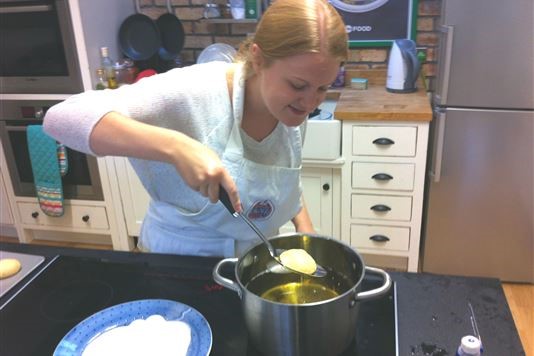
Keen to keep on trend, team lovefood has created their very own cake hybrid - the 'Monut'. Here Charlotte shows you how to make the mincemeat-filled doughnutty treat...
Following the fashion
 Long gone are the days of cupcakes; they've been ousted by something far more complex and, if possible, far sweeter: the cake hybrid. We've already written about the 'Duffin' (doughnut + muffin, first created by Bea Vo at her London bakery Bea's of Bloomsbury) and the 'Cronut' (croissant + doughnut, invented by baker Dominique Ansel in Manhattan), plus last month Waitrose sent us a hot-off-the-shelves batch of 'Yumdoughs' - a ludicrously sweet (but very eatable) blend between a doughnut and a Yum Yum, which comes filled with pockets of fondant (pictured).
Long gone are the days of cupcakes; they've been ousted by something far more complex and, if possible, far sweeter: the cake hybrid. We've already written about the 'Duffin' (doughnut + muffin, first created by Bea Vo at her London bakery Bea's of Bloomsbury) and the 'Cronut' (croissant + doughnut, invented by baker Dominique Ansel in Manhattan), plus last month Waitrose sent us a hot-off-the-shelves batch of 'Yumdoughs' - a ludicrously sweet (but very eatable) blend between a doughnut and a Yum Yum, which comes filled with pockets of fondant (pictured).
Now it's all very well reporting on these new hybrids, but lovefood grabs any opportunity to get cooking in our fancy studio kitchen. So, following a cracking hybrid-bake idea from lovefood's Simon, I took to the stove to invent the 'Monut' - a mincemeat-stuffed doughnut - just in time for Christmas.
How to make a doughnut
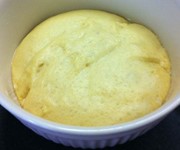 I've never cooked doughnuts before, but the future of a new cake hybrid was at stake so I eagerly kicked things off with a very simple doughnut dough, made from plain flour, dried yeast, a little sugar, beaten egg yolks, and warm milk.
I've never cooked doughnuts before, but the future of a new cake hybrid was at stake so I eagerly kicked things off with a very simple doughnut dough, made from plain flour, dried yeast, a little sugar, beaten egg yolks, and warm milk.
The mix was pretty sloppy and hard to handle, so kneading it proved a sticky affair. I had to keep greasing my hands with vegetable oil to stop the dough from clinging to my fingers, and you can imagine the mess it made on the worktop surface. But no matter - the dough was looking positively alive when I plopped it into a lightly oiled bowl to prove for two hours, and I looked forward to watching it double in size.
Into the fryer we go
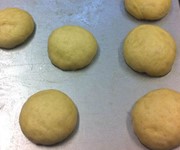 Grow it did, and although the dough was still unusually sticky, I managed to divide the mixture into ten golf ball-shaped pieces, which were then laid aside for a final one hour prove. The resulting blobs were a little flat for my liking (maybe I should have proved them for longer?) but time was ticking and I had to get my makeshift deep-fat fryer ready - the biggest saucepan I could find, filled with a gut-renching three bottles of vegetable oil.
Grow it did, and although the dough was still unusually sticky, I managed to divide the mixture into ten golf ball-shaped pieces, which were then laid aside for a final one hour prove. The resulting blobs were a little flat for my liking (maybe I should have proved them for longer?) but time was ticking and I had to get my makeshift deep-fat fryer ready - the biggest saucepan I could find, filled with a gut-renching three bottles of vegetable oil.
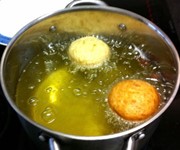 The vat of oil took its time to warm up, and having no thermometer made it difficult to assess when the fat was ready. Luckily, Simon - who as a young lad used to fry doughnuts at a local theme park - was on hand to help, and after a ten minute wait he deemed the oil ready for its first victim.
The vat of oil took its time to warm up, and having no thermometer made it difficult to assess when the fat was ready. Luckily, Simon - who as a young lad used to fry doughnuts at a local theme park - was on hand to help, and after a ten minute wait he deemed the oil ready for its first victim.
My doughnuts sizzled and spat as they rolled about the oil, and took barely two minutes to puff up and turn a beautiful golden brown. A customary dunk in a mound of caster sugar was the final step - now, I was ready to turn those doughnuts into 'monuts'.
Meet the mincemeat
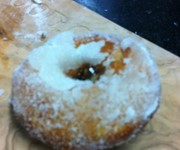 I had to buy some mincemeat (though had I time I'd have made my own) and intended to inject a shot of it into each doughnut using a piping bag. But the whole raisins and shards of suet clogged the nozzle up, and I had to think of another plan. A wider nozzle didn't pierce the doughnut well enough, so instead I decided to blitz my mincemeat in a food processor to create a kind of Christmassy paste.
I had to buy some mincemeat (though had I time I'd have made my own) and intended to inject a shot of it into each doughnut using a piping bag. But the whole raisins and shards of suet clogged the nozzle up, and I had to think of another plan. A wider nozzle didn't pierce the doughnut well enough, so instead I decided to blitz my mincemeat in a food processor to create a kind of Christmassy paste.
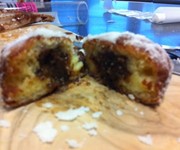 That worked a treat, and I loved clinically injecting each still-warm doughnut with the mixture. The 'monuts' felt much heavier when they were done; I could tell that they were going to be super rich, and that each one would be best shared between two.
That worked a treat, and I loved clinically injecting each still-warm doughnut with the mixture. The 'monuts' felt much heavier when they were done; I could tell that they were going to be super rich, and that each one would be best shared between two.
The reviews
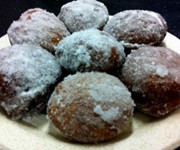 Attracted by the scent of freshly-cooked doughnuts coming from the kitchen, my fellow colleagues descended on the 'monuts' like a flock of gannets and had soon polished the lot off (not even lovefood editor Andrew got a taste [this was noted - Ed.]). Everyone seemed to like them - Cecile said that they were "far tastier than mince pies", and Susan described them as "super scrummy", adding: "They're much lighter and fluffier than a regular doughnut and the addition of mincemeat is inspired! I loved it and will definitely be trying these out on my family for Christmas."
Attracted by the scent of freshly-cooked doughnuts coming from the kitchen, my fellow colleagues descended on the 'monuts' like a flock of gannets and had soon polished the lot off (not even lovefood editor Andrew got a taste [this was noted - Ed.]). Everyone seemed to like them - Cecile said that they were "far tastier than mince pies", and Susan described them as "super scrummy", adding: "They're much lighter and fluffier than a regular doughnut and the addition of mincemeat is inspired! I loved it and will definitely be trying these out on my family for Christmas."
So there you have it - another successful cake hybrid to add to the ever-expanding list. Fancy making it yourself? Check out our 'monut' recipe below...
Ingredients
- 250 g plain flour
- 4 g fast-action dried yeast
- 50 g caster sugar, plus 100g extra for rolling
- 2 medium egg yolks
- 150 ml semi-skimmed milk
- 300 g mincemeat
- 2.5 l vegetable or sunflower oil, for frying
- 1 pinch salt
- 50 g butter, melted
- 8.8 oz plain flour
- 0.1 oz fast-action dried yeast
- 1.8 oz caster sugar, plus 100g extra for rolling
- 2 medium egg yolks
- 5.3 fl oz semi-skimmed milk
- 10.6 oz mincemeat
- 4.4 pints vegetable or sunflower oil, for frying
- 1 pinch salt
- 1.8 oz butter, melted
- 8.8 oz plain flour
- 0.1 oz fast-action dried yeast
- 1.8 oz caster sugar, plus 100g extra for rolling
- 2 medium egg yolks
- 0.6 cup semi-skimmed milk
- 10.6 oz mincemeat
- 10.6 cups vegetable or sunflower oil, for frying
- 1 pinch salt
- 1.8 oz butter, melted
Details
- Cuisine: American
- Recipe Type: Dessert
- Difficulty: Medium
- Preparation Time: 35 mins
- Cooking Time: 10 mins
- Serves: 10
Step-by-step
- Warm the milk in a pan, but don't let it boil. Set aside. Combine the flour, yeast, sugar and salt in a large bowl, then make a well in the middle.
- Gently beat the egg yolks, warmed milk and melted butter together, then tip the mixture into the well and bring together using a knife. The dough will look a little sloppy and rough, but don't worry. Leave to stand for 10 minutes to firm up.
- Lightly coat the work surface and your hands in vegetable or sunflower oil, then tip out the dough and knead for about 5 minutes until it looks smoother and feels springy (re-oil your hands if the dough keeps sticking).
- Transfer the kneaded dough to a large, lightly oiled bowl covered with a tea towel and allow to rise in warm place (I put mine on the floor next to the radiator) for 2 hours, or until doubled in size.
- Tip the dough onto a lightly oiled work surface and give it another quick knead. Shape into golf ball-shaped balls and place on a lightly oiled baking sheet, well spaced apart. Cover again, then leave to rise for 1 hour until the dough no longer springs back when you prod it.
- Now it's time to fry! Gradually bring the oil to the heat, stopping at 180C. If you don't have a thermometer, test the heat by dropping a little bit of dough taken from one of the balls into the pan; if it immediately sizzles and starts to turn golden brown, then you're ready to go. Prepare a plate piled high with caster sugar, and place it close to the fryer.
- Using a slotted spoon, carefully lower each doughnut into the fryer (I did two at a time), cooking each side for about two minutes or until golden brown. Remove the doughnuts from the oil with the slotted spoon and immediately roll in the plate of caster sugar so that the hot fat makes the sugar stick to the sides.
- Set aside and leave to cool until you can handle them. Meanwhile, blitz the mincemeat in a food processor until smooth and fill a piping bag, with nozzle attachment, with it.
- Using a sharp knife, make a cut into the top of each doughnut, reaching to the centre. Pipe the mincemeat paste into the doughnuts generously, stopping when it starts to ooze out.
- Enjoy warm!
You might also like
Comments
Be the first to comment
Do you want to comment on this article? You need to be signed in for this feature